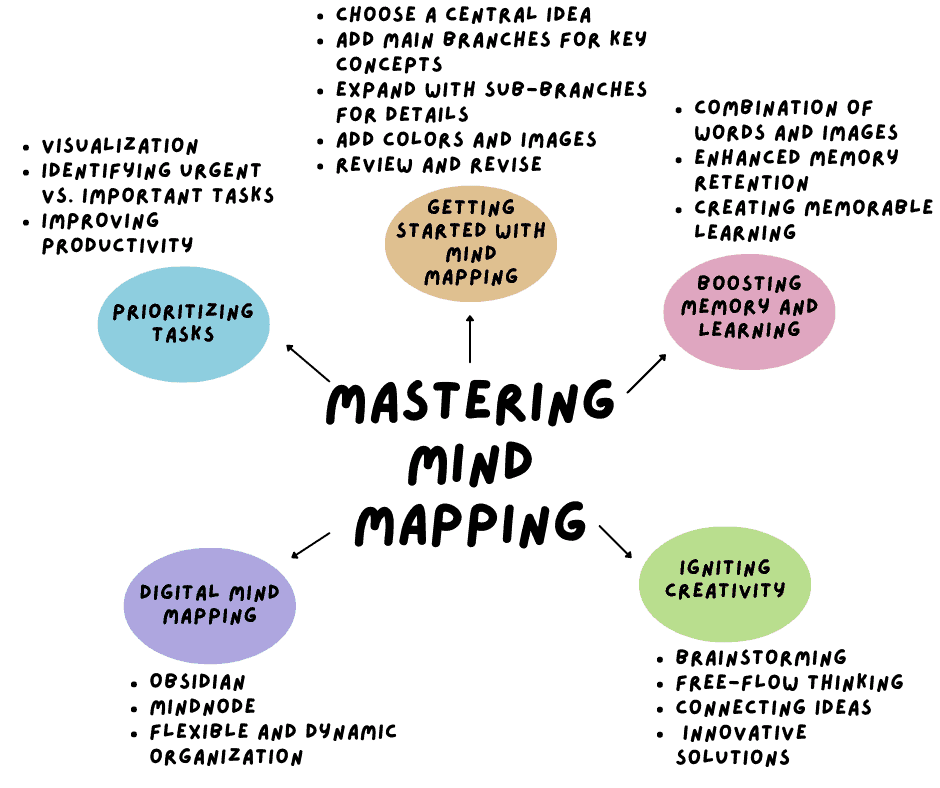We may earn money from the companies mentioned in this post at no additional cost to you.
Mind Mapping for Clarity – it sounds as magical as finding a unicorn in your backyard, doesn’t it? And trust me, it’s just as exciting! If your brain often feels like a tangled ball of wool with thoughts jumbled everywhere, mind mapping is your much-needed kitten, ready to playfully unravel that ball, bit by bit. In this post, we’ll unlock the mythical world of mind mapping, a tool designed to help bring order to your cerebral chaos.
The Magic of Mind Mapping
Mind mapping is like a compass for a wandering explorer. It helps you navigate through the wilderness of your ideas, making sense of where everything is and where everything should go. It’s like turning a disheveled pile of puzzle pieces into a clear, beautiful picture. It creates a visual representation of your thoughts, helping you analyze, comprehend, and generate new ideas.
You might be thinking, “Is this another thing I have to squeeze into my schedule?” Nope! It’s a simple yet effective method that can be easily incorporated into your routine
Crafting a Mind Map: A Step-By-Step Guide
Creating a mind map isn’t rocket science. If anything, it’s a fun and interactive science experiment you can do in the lab of your mind. Here’s your practical guide:
- Pick your central idea: Think of it as your ‘headliner thought’ – the big cheese.
- Branch out with sub-topics: These are the ‘support acts’ for your headliner. Draw lines branching out from the central idea.
- Sprinkle with symbols and colors: It’s the confetti at your thought-party, making your mind map colorful and exciting.
- Add details to each branch: Consider these the ‘behind-the-scenes crew’ that make the headliner and support acts shine.
The Perks of Being a Mind Mapper
Untangling Your Thought-Knots
Think of your mind as a bustling city during peak hour traffic. Thoughts, like cars, are zooming around, taking different routes, stopping, starting, and occasionally colliding into each other. This is the traffic jam in your head when you have too many things on your mind.
Now, picture mind mapping as your city’s traffic management system. It’s your set of traffic signals, one-way streets, and clear road markings. These tools allow each car (thought) to move smoothly along its path without bumping into another. They direct the flow of traffic, maintain order, and reduce the risk of accidents.
Just as this system helps streamline city traffic and reduce stress for its drivers, mind mapping similarly directs the flow of your thoughts. It brings order to your mental hustle and bustle and reduces your cognitive load. This simple, yet efficient system makes navigating your thought-city less overwhelming and more manageable.
Prioritizing Your Tasks: The Strategy Game
Using a mind map to organize your tasks is a great way to prioritize. You list down everything you need to do, and you can easily see which tasks are critical and which ones can wait
.Think of your life as a game of chess. Each piece on the board represents a task or responsibility. Some are pawns, less critical but still significant, while others are queens and rooks, with heavy weight and high importance.
Mind mapping is like a bird’s eye view of your chessboard. It allows you to visualize your tasks, understand their significance, and strategize your moves.
In essence, mind mapping helps transform your hectic game of life into a well-strategized match where every move counts. With it, you can maneuver your tasks efficiently, knowing exactly which piece to move and when.
Igniting Your Creative Spark: Thinking Outside the Box
Mind mapping is also a great tool for brainstorming. It allows your thoughts to flow freely, connecting ideas in ways you might not have considered. It’s about exploring all possibilities, which can lead to innovative solutions and creative breakthroughs.
Picture your creative process as a tranquil riverbed. At times, it’s a steady flow, other times, it might feel like it’s drying up. Mind mapping acts like the sudden rush of a waterfall, infusing the river with energy and bringing it back to life.
Boosting Memory and Learning: A Picture is Worth a Thousand Words
Drawing a mind map uses both words and images, which is a powerful combination for memory retention. By associating information with colors, symbols, or images, you are more likely to remember it. Mind mapping isn’t just about jotting down notes; it’s about creating a vibrant and memorable representation of what you’ve learned
Digital Mind Mapping: The Tech-Savvy Approach
I knew you were waiting for this section – tech nerds unite! Online tools like MindMeister, XMind, Obsidian, and MindNode are the Harry Potters of mind mapping – giving you the magical ability to create, edit, and share your mind maps with a flick of your wand (or rather, a click of your mouse)! It’s a flexible and dynamic way to organize your thoughts and ideas.
Who says you need to stick to the pen and paper?

Wrapping Up
Just like a treasure hunt, mind mapping can reveal the golden nuggets hidden within your thoughts. It’s not about stuffing your treasure chest to the brim, but about sifting through and finding the gems that truly matter.




